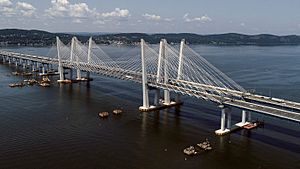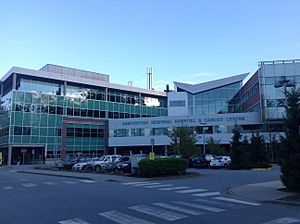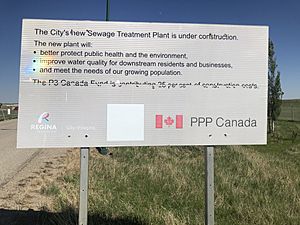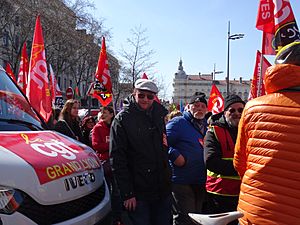Public-private partnership facts for kids
A public-private partnership (often called a PPP) is a special agreement. It's like a contract between a government (the public sector) and a private company. The main goal of these partnerships is to provide important public services. These services can be things like building schools for education or roads for transportation.
In a PPP, the private company helps provide a service. But it doesn't become a government-owned business. Instead, the government might pay the company to offer services to the public for free. The company gives the service, and then the government pays them for their work. People who support PPPs say they can make things work better and faster. They also believe PPPs give the free market more freedom to try new ideas.
Contents
What is a Public-Private Partnership?
A public-private partnership is a way for governments and private businesses to work together. They team up to create or manage projects that benefit everyone. These projects are usually things that the government would normally do.
How PPPs Work
Imagine a city needs a new bridge. Instead of the city building it all by itself, it might partner with a private construction company.
- The company builds the bridge.
- The city might pay the company over many years.
- Sometimes, the company might even manage the bridge, like collecting tolls.
This way, the government gets the project done. And the private company gets paid for its skills and work.
Why Governments Use PPPs
Governments use PPPs for several reasons:
- Sharing Costs: Private companies can help pay for big projects. This means the government doesn't have to pay everything upfront.
- Getting Expertise: Private companies often have special skills or new technologies. They can bring these to public projects.
- Faster Projects: Sometimes, private companies can build things more quickly than government departments.
- Better Management: Private companies might manage projects more efficiently. This can save money in the long run.
Types of Public-Private Partnerships
There are different ways governments and companies can work together. The type of PPP depends on the project.
Build-Operate-Transfer (BOT)
In a BOT partnership, a private company:
- Builds a project, like a power plant or a highway.
- Operates it for a set number of years. They might collect fees, like tolls, during this time.
- Then, they transfer ownership back to the government.
This is a common way to build large infrastructure projects.
Design-Build-Finance-Operate (DBFO)
A DBFO partnership is similar to BOT but includes the design phase. The private company:
- Designs the project.
- Builds it.
- Finances it (finds the money to pay for it).
- Operates it for a long time.
The government usually pays the company a fee for its services.
Examples of PPP Projects
PPPs are used for many different kinds of projects around the world.
Transportation Projects
Many roads, bridges, and airports are built using PPPs.
- A private company might build a new highway. They then collect tolls from drivers for many years. This helps them get back the money they spent building it.
- Some train lines or subway systems also use PPPs for their construction or operation.

Healthcare Facilities
Hospitals and clinics can also be built through PPPs.
- A private company might build a new hospital building.
- The government then uses the building to provide healthcare services.
- Sometimes, the private company also helps manage parts of the hospital.
Water and Wastewater Systems
PPPs are often used for water treatment plants and sewer systems.
- A private company might build or upgrade a water treatment plant.
- They then operate it to make sure clean water is supplied to homes.
- They also manage the treatment of wastewater.
Benefits and Challenges of PPPs
Like any big project, PPPs have good points and some challenges.
Benefits of PPPs
- Innovation: Private companies can bring new ideas and technologies.
- Risk Sharing: The private company often shares some of the financial risks.
- Efficiency: Private companies might be able to complete projects more quickly and at a lower cost.
- New Funding: PPPs can help governments start projects they might not have enough money for otherwise.
Challenges of PPPs
- Higher Costs: Sometimes, PPPs can end up being more expensive for the government in the long run.
- Less Control: The government might have less direct control over the project once a private company is involved.
- Complexity: PPP contracts can be very complicated. It takes a lot of effort to set them up correctly.
- Public Concerns: Some people worry that private companies might focus too much on making money. They might not always put public service first.
Images for kids
-
Gavin Newsom hosts a meeting for employers about public-private partnerships. (13 November 2019)
-
The main toll plaza of the Dulles Toll Road concession in Virginia, whose price is periodically increasing.
See also
 In Spanish: Alianza público-privada para niños
In Spanish: Alianza público-privada para niños










